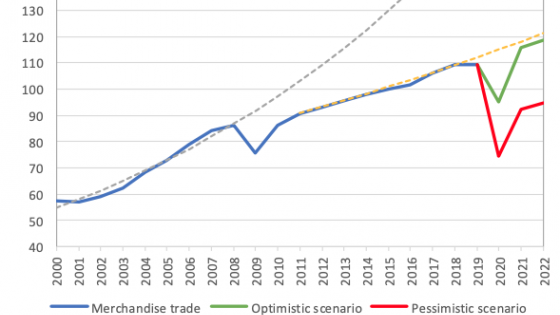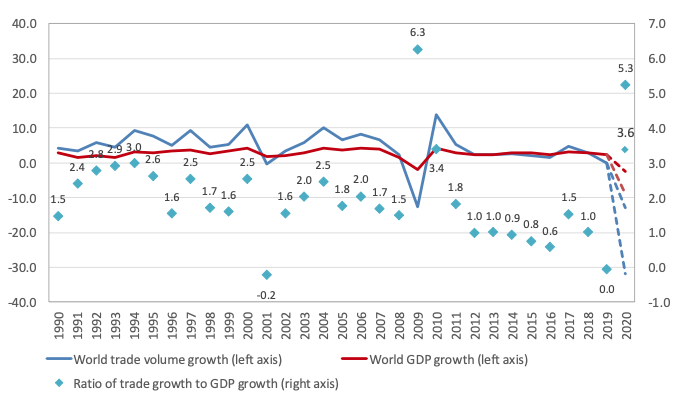Covid-19 is rapidly changing the world. At the WTO, we aim to better understand how this pandemic is likely to affect global trade in the near and longer term.
As the virus spreads across the globe, most countries eventually choose the strongest form of social distancing: suppression. The policy of suppression has provoked large changes in the organisation of society, which in turn have had large economic effects. Entire sectors of the economy are shuttered or forced to operate at a fraction of their normal capacity. Meanwhile, demand for goods and services is drastically reduced due to lost income and uncertainty about the future. Restrictions on international travel and increased border controls have raised international trade costs and prevented tradeable services from being supplied or consumed. In some cases, exports of medical supplies and food have been banned, while shortages of parts and components have interrupted production in industries characterised by complex value chains (Evenett 2020).
Governments have responded with large-scale fiscal and monetary interventions to support household and business income and to maintain financial stability (Gopinath 2020). Still, indicators of economic activity in the US, Europe and China are dropping to record lows. Economic prediction is extremely difficult under these circumstances, with many complex and interrelated factors determining actual outcomes, including the question how long social distancing measures will stay in place and what an exit strategy might look like (Baldwin and Tomuira 2020). Despite this pervasive uncertainty, the WTO developed a trade forecast to inform policymakers on the potential impact of the current COVID-19 crisis on trade, and to provide a baseline against which progress can be measured. Understanding developments in global trade may help policymakers craft solutions for both the short-term and long-term recoveries from this crisis.
Recent growth in trade
After the financial crisis of 2008-09, trade never returned to its previous trend, represented by the dotted grey line in Figure 1. Trade growth in the lead up to the financial crisis had been heavily influenced by the opening up of China, the formally centrally planned European countries, and India in the 1980s and 1990s, along with significant multilateral, regional, and unilateral liberalization efforts. As seen in Figure 2 the trade elasticity (the ratio of trade growth to GDP growth) in the 1990s was often greater than 2, while the long-term average is about 1.4. After the financial crisis, trade growth slowed and the trade elasticity fell back, even below its long-term average. Important drivers of trade growth have decelerated, notably GDP growth and its trade-intensive elements in particular such as investment growth, which has shown considerable weakness after the financial crisis. Additionally, liberalisation efforts have slowed, and policy uncertainty has increased, notably in light of recent trade tensions.
Trade was already slowing significantly in 2019 before the virus struck, weighed down by this increased uncertainty and a broad slowing of economic growth. World merchandise trade registered a slight decline for the year of 0.1% in volume terms after rising by 2.9% in 2018. Meanwhile, the dollar value of world merchandise exports in 2019 fell by 3% to US$ 18.89 trillion. In contrast, world commercial services trade increased in 2019, with exports in dollar terms rising by 2% to US$ 6.03 trillion. The pace of expansion was slower than in 2018, when services trade increased by 9%.
Figure 1 World merchandise trade volume, 2000 2022
(Index, 2015=100)
Source: WTO Secretariat.
Building the trade forecast
Forecasting under the circumstances described above requires strong assumptions about disease progression and a greater reliance on estimated rather than reported data. Normally, a critical component of our traditional trade forecasting model is a consensus GDP forecast by region. However, existing GDP forecasts this year had not yet incorporated impacts of the health related global shut down on GDP. We therefore decided to estimate our own GDP impacts, similar to, for example, McKibbin and Fernando (2020). To organise our thinking on this effort, we built three scenarios – notably because of the level of uncertainty about the duration of the pandemic and the containment measures – and projected the economic effects with the WTO Global Trade Model, a dynamic computable general equilibrium model.
- In an optimistic scenario, the measures will stay in place for three months and after that there will be a V-shaped recovery.
- In a less optimistic scenario, measures stay in place for six months, leading to a U-shaped recovery.
- In a pessimistic scenario, the suppression measures will have to stay in place for the entire year of 2020 with limited recovery in 2021, leading to an L-shaped recovery.
Three shocks are imposed to model the pandemic and containment measures: (i) a general reduction of labour supply; (ii) a rise in trade costs; and (iii) reductions in both demand and supply in sectors most affected by the containment measures. GDP is projected to fall by, respectively, 5% and 11% in the V-shaped and L-shaped scenarios relative to baseline projections. The model also projected trade to fall by 8% and 20% respectively compared to baseline estimates. While there are a number of useful insights from the simulation-based trade numbers, we used our judgement to take the GDP estimates and plug them into our traditional time series-based trade forecasting model, which normally performs better in the short term (Keck et al. 2009).
In the simulation model, the L-shaped scenario results in a trade-to-GDP elasticity of 2.1,1 whereas this elasticity was between 4 and 6 in the financial crisis (Figure 2). With the simulated GDP results, our time series model produces trade elasticities closer to the latter. Different factors are of course at play. On the one hand, the reduction in demand was more concentrated in highly tradable durable manufacturing goods in the financial crisis than what is expected in the current crisis, which particularly affects non-tradable sectors. Furthermore, the simulations of the current crisis do not take into account the bullwhip effect, whereby firms run down inventories leading to a magnified trade response to a fall in demand, an important factor contributing to the high trade elasticity in 2008.
Figure 2 Ratio of world merchandise trade growth to world GDP growth, 1990 2020 (% change and ratio)
Source: WTO Secretariat for trade and consensus estimates for historical GDP. Projections for GDP based on scenarios simulated with WTO Global Trade Model.
On the other hand, trade costs are expected to rise considerably in this crisis, a factor that did not play a big role during the financial crisis according to the economic literature on this topic. In both crises, governments have intervened with monetary and fiscal policy to counter the downturn and provide temporary income support to businesses and households. But restrictions on movement and social distancing to slow the spread of the disease mean that labour supply, transport and travel are today directly affected in ways they were not during the financial crisis. As noted above, whole sectors of national economies also have been shut down, unlike a decade ago.
Outlook for trade in 2020 and 2021
Future trade performance as summarised in Table 1 presents two distinct scenarios:2 (1) a relatively optimistic scenario, with a sharp drop in trade followed by a recovery starting in the second half of 2020; and (2) a more pessimistic scenario with a steeper initial decline and a more prolonged and incomplete recovery. These should be viewed as explorations of different possible trajectories for the crisis rather than specific predictions of future developments. Actual outcomes could easily be outside of this range, either on the upside or the downside.
Table 1 Merchandise trade volume and real GDP, 2018-20211 (annual % change)
Notes: 1) Figures for 2020 and 2021 are projections. 2) Average of exports and imports. 3) Other regions comprise Africa, Middle East and Commonwealth of Independent States (CIS) including associate and former member States.
Source: WTO Secretariat for trade and consensus estimates for historical GDP. Projections for GDP based on scenarios simulated with WTO Global Trade Model.
Under the optimistic scenario, the recovery will be strong enough to bring trade close to its pre-pandemic trend, represented by the dotted yellow line in Figure 1, while the pessimistic scenario only envisages a partial recovery. Given the level of uncertainties, it is worth emphasising that the initial trajectory does not necessarily determine the subsequent recovery. For example, one could see a sharp decline in 2020 trade volumes along the lines of the pessimistic scenario, but an equally dramatic rebound, bringing trade much closer to the line of the optimistic scenario by 2021 or 2022.
A strong rebound is more likely if businesses and consumers view the pandemic as a temporary, one-time shock. In this case, spending on investment goods and consumer durables could resume at close to previous levels once the crisis abates. On the other hand, if the outbreak is prolonged and/or recurring uncertainty becomes pervasive, households and business are likely to spend more cautiously.
The impact of the COVID-19 outbreak on international trade is not yet visible in most trade data, but some timely and leading indicators may already yield clues about the extent of the slowdown and how it compares to earlier crises. Indices of new export orders derived from Purchasing Managers' Indices (PMIs) are particularly useful in this regard. The JP Morgan global PMI for March, for instance, showed export orders in manufacturing sinking to 43.3 relative to a baseline value of 50 and new services export business dropping to 35.5, suggesting a severe downturn.
Concluding remarks
In conclusion, the WTO expects a significant downturn in global trade in 2020 of between 13% and 32%, and some recovery in 2021 (Table 1), with the results being very sensitive to the length of time that the Covid-19 threat and related health measures remain in place. We will be revisiting both our simulation model scenarios and trade forecast as the year progresses and new information becomes available allowing us to refine our scenario shocks and re-estimate how impacts seem to be presenting themselves across countries and regions.
Authors note: The opinions expressed in this column should be attributed only to its authors. They are not meant to represent the positions or opinions of the WTO and its Members and are without prejudice to Members’ rights and obligations under the WTO. Any errors are attributable to the authors.
References
Baldwin, R and E Tomiura (2020), “Thinking ahead about the trade impact of COVID-19”, in R Baldwin and B Weder di Mauro (eds), Economics in the Time of COVID-19, a VoxEU eBook, CEPR Press.
Baldwin, R and B Weder di Mauro (eds) (2020a) Economics in the Time of COVID-19, a VoxEU eBook, CEPR Press.
Baldwin, R and B Weder di Mauro (eds) (2020b) Mitigating the COVID Economic Crisis: Act Fast and Do Whatever It Takes, a VoxEU eBook, CEPR Press.
Evenett, S (2020), Tackling Covid-19 Together: The Trade Policy Dimension, GTA Report.
Gopinath, G (2020), “Limiting the economic fallout of the coronavirus with large targeted policies”, Baldwin, R and B Weder di Mauro (eds) (2020b) Mitigating the COVID Economic Crisis: Act Fast and Do Whatever It Takes, a VoxEU eBook, CEPR Press.
Keck, A, A Raubold and A Truppia (2009), “Forecasting International Trade: A Time Series Approach”, OECD Journal: Journal of Business Cycle Measurement and Analysis 9(2): 1-20.
McKibbin, W and R Fernando (2020), “The Global Macroeconomic Impacts of Covid-19: Seven Scenarios”, Brookings.
Endnotes
1 In the simulation model, the response of trade to the reduction in GDP is projected to rise as the crisis lasts longer, as this leads to a larger drop in spending on durables which are highly tradable.
2 How these scenarios were generated is discussed in more detail in a background document that can be downloaded from the WTO website here.









